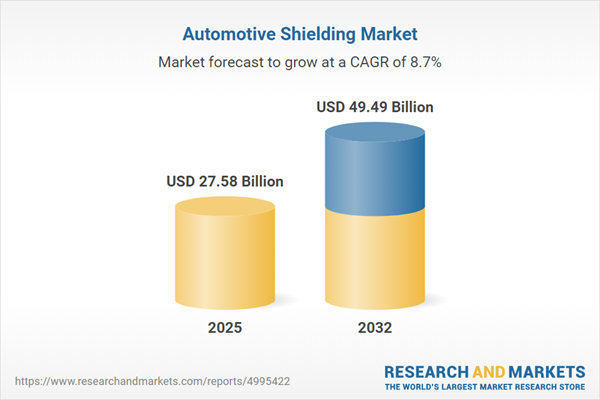Speak directly to the analyst to clarify any post sales queries you may have.
Automotive shielding plays a central role in enhancing vehicle reliability and safety amid ongoing shifts toward electrification and digital connectivity. Its importance grows as automakers and suppliers face new materials, compliance, and manufacturing demands, making high-integrity shielding essential for next-generation vehicle success.
Market Snapshot: Automotive Shielding Market Growth Outlook
The Automotive Shielding Market grew from USD 25.46 billion in 2024 to USD 27.58 billion in 2025. It is expected to continue growing at a CAGR of 8.65%, reaching USD 49.49 billion by 2032. This growth is propelled by factors such as the rapid adoption of electric drivetrains, increased integration of advanced driver assistance systems, and the expansion of autonomous mobility solutions. Demand is especially pronounced for high-performance shielding applications, which are now integral to regulatory compliance and thermal management in both OEM and aftermarket channels.
Scope & Segmentation of the Automotive Shielding Market
This report delivers comprehensive coverage of the automotive shielding landscape, segmented by solution, region, end use, and manufacturing technology to enable targeted strategic planning.
- Material Types: Aluminum, copper, steel, ceramic materials, thermal interface materials
- Shielding Types: Electromagnetic interference (EMI) shielding, heat shielding
- Manufacturing Technologies: Casting, coating, molding, stamping
- Vehicle Classes: Heavy commercial vehicles, light commercial vehicles, hatchbacks, sedans, SUVs
- Applications: Chassis, electronics, engine compartment, exhaust system
- End Users: OEMs, aftermarket
- Regions: Americas, Europe, Middle East & Africa, Asia-Pacific
Leading Companies Analyzed:
- 3M Company
- ACS Industries, Inc.
- Autoneum Holding AG
- Boyd Corporation
- CERTINA Group
- Dana Incorporated
- Henkel AG & Co. KGaA
- Kitagawa Corporation
- KRAIBURG TPE GmbH & Co. KG
- Lydall, Inc.
- Marian, Inc.
- Morgan Advanced Materials PLC
- Nichias Corporation
- Parker Hannifin Corporation
- Rogers Corporation
- RTP Company, Inc.
- S&A Industries
- Saint-Gobain Performance Plastics
- Stockwell Elastomerics Inc.
- Tenneco Inc.
- Vibracoustic GmbH
- Zircotec Ltd
Key Takeaways: Strategic Insights for Decision-Makers
- Material innovation is accelerating, with advanced ceramics and selective alloys reducing weight and enhancing heat resistance for new vehicle platforms.
- Precision manufacturing processes, such as coating and micro-stamping, are enabling tailored solutions for sensitive electronics and powertrain components.
- OEMs and suppliers are investing in digital simulation and additive manufacturing, driving faster prototyping and improved predictive maintenance capabilities.
- Strategic partnerships between automakers and materials specialists are shaping integrated approaches to meet evolving regulatory and commercial requirements.
- Segment differentiation is critical, as commercial vehicles demand robust thermal solutions while passenger cars prioritize lightweight, integrated shielding for improved efficiency and comfort.
Tariff Impact on Automotive Shielding
Revised United States tariffs implemented in 2025 have altered sourcing strategies and increased cost pressures across the automotive shielding value chain. Manufacturers have responded by diversifying supplier portfolios, strengthening ties with domestic and regional material providers, and localizing certain production steps. These adjustments are driving agile supply chain management, influencing component pricing, and reconfiguring competitive dynamics in both OEM and aftermarket sectors.
Methodology & Data Sources
This report integrates in-depth primary and secondary research, drawing on executive interviews with OEMs, suppliers, and technical experts, alongside thorough analysis of global standards and industry publications. Triangulation of qualitative and quantitative data ensures robust, actionable findings tailored to senior leadership needs.
Why This Report Matters
- Enables decision-makers to evaluate emerging material, manufacturing, and supply chain strategies for improved operational resilience.
- Offers a roadmap to regulatory compliance and best practices, supporting faster certification and market entry across global regions.
- Supports informed investment decisions through granular segment, application, and regional analysis.
Conclusion
Automotive shielding is evolving rapidly in response to electrification, digitalization, and regulatory imperatives. Strategic material innovation, agile supply chains, and informed partnerships will be key to commercial success and long-term competitiveness in this dynamic sector.
Additional Product Information:
- Purchase of this report includes 1 year online access with quarterly updates.
- This report can be updated on request. Please contact our Customer Experience team using the Ask a Question widget on our website.
Table of Contents
3. Executive Summary
4. Market Overview
7. Cumulative Impact of Artificial Intelligence 2025
Companies Mentioned
The companies profiled in this Automotive Shielding market report include:- 3M Company
- ACS Industries, Inc.
- Autoneum Holding AG
- Boyd Corporation
- CERTINA Group
- Dana Incorporated
- Henkel AG & Co. KGaA
- Kitagawa Corporation
- KRAIBURG TPE GmbH & Co. KG
- Lydall, Inc.
- Marian, Inc.
- Morgan Advanced Materials PLC
- Nichias Corporation
- Parker Hannifin Corporation
- Rogers Corporation
- RTP Company, Inc.
- S&A Industries
- Saint-Gobain Performance Plastics
- Stockwell Elastomerics Inc.
- Tenneco Inc.
- Vibracoustic GmbH
- Zircotec Ltd
Table Information
| Report Attribute | Details |
|---|---|
| No. of Pages | 199 |
| Published | November 2025 |
| Forecast Period | 2025 - 2032 |
| Estimated Market Value ( USD | $ 27.58 Billion |
| Forecasted Market Value ( USD | $ 49.49 Billion |
| Compound Annual Growth Rate | 8.6% |
| Regions Covered | Global |
| No. of Companies Mentioned | 23 |









